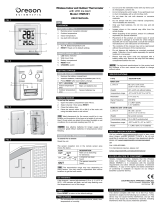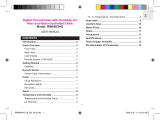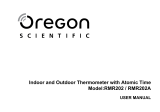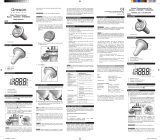Oregon Scientific THN 132N Manuel utilisateur
- Catégorie
- Stations météo
- Taper
- Manuel utilisateur
Ce manuel convient également à

batterie al litio.
Per ottenere risultati migliori:
•
Posizionare il sensore al riparo da luce solare diretta
e umidità.
•
Non posizionare il sensore a più di 30 metri (100
piedi) dall’unità interna principale.
•
Posizionare il sensore in modo che si trovi di fronte
all’unità principale, riducendo al minimo le ostruzioni
causate da porte, pareti e mobili.
•
Posizionare il sensore senza ostruzione verso il
cielo, lontano da oggetti metallici o elettronici.
•
Posizionare il sensore vicino all’unità principale
durante i mesi più freddi, dal momento che le
temperature inferiori allo zero possono influire sulle
prestazioni della batteria e sulla trasmissione del
segnale.
Il campo di trasmissione può variare in base a molti
fattori. È possibile dover provare diverse posizioni
prima di ottenere i risultati migliori.
Le batterie alcaline standard contengono un’alta
percentuale d’acqua, per questo motivo gelano alle
basse temperature, a circa -12°C (10°F). Le batterie
monouso al litio hanno invece una soglia molto inferiore,
e gelano approssimativamente sotto i -30°C (-22°F).
Quando si è in modalità senza fili, sul campo influiscono
diversi fattori, tra cui le temperature particolarmente
rigide. Il freddo intenso può ridurre temporaneamente
il campo d’azione tra il sensore e la stazione base.
Se le prestazioni dell’unità sono scarse a causa delle
basse temperature, l’unità ricomincerà a funzionare
correttamente a mano a mano che la temperatura
aumenta fino a rientrare nella norma (quindi l’unità non
subirà alcun danno permanente a causa delle basse
temperature).
RESET
Premere RESET per ripristinare le impostazioni
predefinite dell’unità.
AVVERTENZE
Questo prodotto è progettato per offrire anni di
funzionamento soddisfacente purché maneggiato con
cura. Attenersi alle seguenti avvertenze:
•
Non immergere l’unità in acqua. Se si versa del
liquido sul prodotto, asciugarlo immediatamente
con un panno morbido e liscio.
•
Non pulire l’unità con materiali abrasivi o corrosivi.
•
Non sottoporre l’unità a forza o a urti eccessivi,
né esporre a polvere e a oscillazioni di
temperatura o di umidità che potrebbero
causarne il malfunzionamento, la minore durata, il
danneggiamento delle batterie o la deformazione di
alcune parti.
•
Non manomettere i componenti interni. In questo
modo si invalida la garanzia del prodotto e si possono
provocare danni. L’unità non contiene componenti
che possono essere riparati dall’utente.
•
Usare solo batterie nuove del tipo e nel modo
specificati nel manuale per l’utente. Non mescolare
batterie nuove con batterie vecchie.
•
Non utilizzare batterie ricaricabili.
•
Togliere le batterie se si prevede di non utilizzare il
prodotto per un lasso di tempo prolungato.
•
A causa di limitazioni di stampa, le immagini di
questo manuale possono differire dalla realtà.
•
Il contenuto di questo manuale non può essere
ristampato senza l’autorizzazione del fabbricante.
•
Non smaltire questo prodotto come rifiuto non
differenziato. È necessario che questo rifiuto venga
smaltito mediante raccolta differenziata per essere
trattato in modo particolare.
NOTA Le specifiche tecniche del prodotto e il contenuto
del manuale per l’utente possono essere modificati
senza preavviso.
RISOLUZIONE DEI PROBLEMI
PROBLEMA SINTOMO SOLUZIONE
Sensore Impossibile localizzare Controllare le batterie
remoto il sensore remoto Controllare la posizione
Impossibile Controllare i sensori.
cambiare
Funziona solo un
il canale sensore
I dati non Avviare la ricerca
corrispondono manuale del sensore
all’unità principale
Wireless Remote Temperature Sensor
Model: THN132N
USER MANUAL
INTRODUCTION
Thank you for selecting the Oregon Scientific
TM
Wireless
Remote Temperature Sensor (THN132N). This product
is compatible with various wireless weather
station
products.
Keep this manual handy as you use your new product.
It contains practical step-by-step instructions, as well as
technical specifications and warnings you should know
about.
OVERVIEW
1. LED indicator 1. Wall mount
2. Battery compartment
3. Battery door
4. Table stand
5.
RESET hole
6.
CHANNEL switch
GETTING STARTED
To set up the sensor:
1. Slide open the battery door.
2. Insert the batteries, matching the polarity (+ /
-).
Reset after each battery change.
3. Select a channel. Make sure you use a different
channel for each sensor.
4. Close the battery compartment.
5. Place sensor next to the main unit.
6. Initiate a sensor search on the main unit to start
receiving temperature data from the sensor.
7. Secure the sensor in the desired location
using the
wall mount or table stand.
NOTE Install batteries in the remote sensor before the
main unit. Press
RESET after each battery change. Do
not use rechargeable batteries. We recommend that
you use alkaline batteries with this product for longer
usage and lithium batteries in temperatures below
freezing.
1 2 3
1
2
3
4
6
5
1
EN
Kabelloser Temperatursensor
Modell: THN132N
BEDIENUNGSANLEITUNG
EINLEITUNG
Wir danken Ihnen, dass Sie sich für den kabellosen
Temperatursensor (THN132N) von Oregon Scientific
TM
entschieden haben. Dieses Produkt ist mit vielen
kabellosen Wetterstationen kompatibel.
Halten Sie bitte diese Anleitung bereit, wenn Sie Ihr
neues Produkt in Betrieb nehmen. Sie enthält praktische
Schritt-für-Schritt-Anweisungen sowie technische Daten
und für Sie wichtige Warnhinweise.
ÜBERSICHT
1. LED-Indikator 1. Wandaufhängung
2. Batteriefach
3. Batteriedeckel
4. Tischaufsteller
5. RESET-Öffnung
6. CHANNEL-Schalter
ERSTE SCHRITTE
So richten Sie den Sensor ein:
1. Öffnen Sie den Batteriedeckel.
2. Legen Sie die Batterien ein und achten Sie auf die
Übereinstimmung der Polarität (+ / -). Nach jedem
Batteriewechsel auf Reset drücken.
3. Wählen Sie einen Kanal aus. Stellen Sie sicher,
dass Sie für jeden Sensor einen eigenen Kanal
verwenden.
4. Schließen Sie das Batteriefach.
5. Platzieren Sie den Sensor in der Nähe der
Basiseinheit.
6. Veranlassen Sie eine Sensorsuche auf der
Basiseinheit, um den Empfang von Temperaturdaten
durch den Sensor zu starten.
7. Befestigen Sie den Sensor an der gewünschten
Stelle mit der Wandaufhängung oder dem
Tischaufsteller.
HINWEIS Installieren Sie die Batterien zuerst im
externen Sensor und anschließend in der Basiseinheit.
Nach jedem Batteriewechsel auf RESET drücken.
Verwenden Sie keine wiederaufladbaren Batterien.
Es wird empfohlen, dass Sie Akaline-Batterien für
eine längere Betriebsdauer und Lithium-Batterien für
Temperaturen unter dem Gefrierpunkt verwenden.
CARACTERISTIQUES
TYPE DESCRIPTION
Dimensions 96 x 50 x 22 mm
(L x E x P)
(3,8 x 2,0 x 0,9 pouces)
Poids 62 g (2,22 onces) sans piles
Unité de mesure de la température – °C / °F
Gamme intérieure -30°C à 60°C (-22°F à 140°F)
Résolution 0,1°C (0,2°F)
Fréquence radio 433MHz
Distance de 30 m (100 pieds) maxi.
transmission sans obstructions
Transmission
Toutes les 40 secondes approx
Numéro des canaux 1, 2 ou 3
Alimentation 1 x UM-3 (AA) 1,5V
REMARQUE Nous vous recommandons d’utiliser des
piles alcalines pour un usage prolongé et des piles au
lithium lors de températures inférieures au gel.
A PROPOS D’OREGON SCIENTIFIC
En consultant notre site internet (www.oregonscientific.fr),
vous pourrez obtenir des informations sur les produits
Oregon Scientific: photo numérique; lecteurs MP3;
produits et jeux électroniques éducatifs; réveils; sport
et bien-être; stations météo; téléphonie. Le site indique
également comment joindre notre service après-vente.
Nous espérons que vous trouverez toutes les
informations dont vous avez besoin sur notre site,
néanmoins, si vous souhaitez contacter le service client
Oregon Scientific directement, allez sur le site
www2.oregonscientific.com/service/
default.asp
ou
appelez le 1-800-853-8883 aux US.
Pour des demandes internationales, rendez vous sur
le site:
www2.oregonscientific.com/about/international.asp
EU - DÉCLARATION DE CONFORMITÉ
Par la présente Oregon Scientific déclare Capteur de
Température à Distance Sans Fil (Modèle THN132N)
est conforme aux exigences essentielles et aux autres
dispositions pertinentes de la directive 1999/5/CE. Une
copie signée et datée de la déclaration de conformité
est disponible sur demande auprès de notre Service
Client.
Pour obtenir de meilleurs résultats :
•
Ne placez pas le capteur directement face
aux rayons du soleil ou en contact avec de la
moisissure.
•
Ne placez pas le capteur à plus de 30 mètres (100
pieds) de l’appareil principal (intérieur).
•
Positionnez le capteur de manière à ce qu’il soit
face à l’appareil principal (intérieur), minimisant
ainsi les obstructions comme les portes, murs ou
les meubles.
•
Placez le capteur directement vers le ciel, éloigné
des objets métalliques et électroniques.
•
Positionnez le capteur à proximité de l’appareil
principal pendant les mois d’hiver puisque le gel
peut endommager le fonctionnement des piles et la
transmission du signal.
La distance de transmission peut varier en fonction
de plusieurs facteurs. Vous pouvez expérimenter
plusieurs emplacements afin d’obtenir les meilleurs
résultats possibles.
Les piles alcalines standard sont composées d’un
volume d’eau non négligeable. Par conséquent, elles
peuvent geler lors de températures inférieures à -12°C
(10°F). Les piles aux lithium ont un seuil inférieur lors
de températures froides, elle ne peuvent en effet geler
qu’à -30°C (-22°F).
Les ondes radios peuvent être endommagées par divers
facteurs comme les températures extrêmement froides.
En effet, le froid intense peut temporairement réduire le
champ radio entre le capteur et la station de base. Si
un disfonctionnement de l’appareil est remarqué du à
des températures froides, l’appareil reviendra en mode
de fonctionnement normal dès que la température
repassera dans une gamme acceptable (ainsi aucun
dommage permanent ne sera remarqué).
RESET (REINITIALISER)
Appuyez sur RESET pour que l’appareil revienne aux
réglages par défaut.
PRECAUTIONS
Ce produit est conçu pour vous donner satisfaction
pendant de nombreuses années si vous le manipulez
avec soins. Voici quelques précautions à prendre en compte :
•
Ne pas immerger le produit dans l’eau. Si vous
renversez du liquide sur l’appareil, séchez-le
immédiatement avec un tissu doux.
•
Ne pas nettoyer l’appareil avec des matériaux
corrosifs ou abrasifs.
•
Ne pas soumettre l’appareil à une force excessive,
aux chocs, à la poussière, la température ou
l’humidité, ce qui pourrait rendre l’appareil
défectueux, réduire sa durée de vie, endommager
les piles et tordre les pièces.
•
Ne pas trafiquer les composants internes. Ce qui
pourrait causer des dommages inutiles et annuler
votre garantie. L’appareil est composé de parties
non accessibles aux utilisateurs.
•
N’utilisez que des piles neuves comme indiquées
dans le manuel. Ne pas mélanger des piles neuves
et usagées.
•
Ne pas utiliser de piles rechargeables.
•
Retirez les piles si vous rangez l’appareil pour une
période indéterminée.
•
En raison des limitations d’impressions, les images
de ce manuel peuvent être différentes de l’affichage
actuel.
•
Le contenu du présent manuel ne peut être reproduit
sans la permission du fabriquant.
•
Ne pas jeter ce produit dans les containers municipaux
non adaptés Veuillez effectuer le tri de ces ordures
pour un traitement adapté si nécessaire.
REMARQUE Les caractéristiques techniques de ce
produit et le contenu de ce manuel peuvent être soumis
à modifications sans préavis.
DEPANNAGE
PROBLEME SYMPTOME SOLUTION
Capteur à Impossibilité Vérifier les piles
distance de situer le capteur Vérifier l’emplacement
Impossibilité de Vérifier les capteurs.
changer de canal
Seul un capteur
est en fonctionnement
Les données ne Initiez une
correspondent pas recherche manuelle
à l’appareil principal du capteur.
SPECIFICATIONS
TYPE DESCRIPTION
Dimensions 96 x 50 x 22 mm
(L x W x D)
(3.8 x 2.0 x 0.9 in)
Weight 62 g (2.22
oz) without battery
Temperature
unit – °C / °F
Outdoor range -30°C to 60°C (-22°F to 140°F)
Resolution 0.1
°C (0.2°F)
RF frequency 433MHz
Range Up t
o 30 m (100 ft)
with no obstructions
Transmission Approx. every 40 seconds
Channel no. 1, 2 or 3
Power 1 x UM-3 (AA) 1.5V battery
NOTE We recommend that you use alkaline batteries
with this product for longer usage and lithium batteries
in temperatures below freezing.
ABOUT OREGON SCIENTIFIC
Visit our website (www.oregonscientific.com) to learn
more about Oregon Scientific products such as
digital cameras; MP3 players; children’s electronic
learning products and games; projection clocks; health
and fitness gear; weather stations; and digital and
conference phones. The website also includes contact
information for our Customer Care department in case
you need to reach us, as well as frequently asked
questions and customer downloads.
We hope you will find all the information you need on
our website, however if you’re in the US and would
like to contact the Oregon Scientific Customer Care
department directly, please visit:
www2.oregonscientific.com/service/
default.asp
OR
Call 1-800-853-8883.
For international inquiries, please visit:
www2.oregonscientific.com/about/international.asp
INDUSTRY CANADA STATEMENT
Operation is subject to the following two conditions:
(1) this device may not cause interference, and (2)
this device must accept any interference, including
interference that may cause undesired operation of the
device.
IC number: 3277A-THN132N
EU-DECLARATION OF CONFORMITY
Hereby, Oregon Scientific, declares that the Wireless
Remote Temperature Sensor (THN132N) is in
compliance with the essential requirements and other
relevant provisions of Directive 1999/5/EC.
A copy of the signed and dated Declaration of
Conformity is available on request via our Oregon
Scientific Customer Service.
FCC STATEMENT
This device complies with Part 15 of the FCC Rules.
Operation is subject to the following two conditions: (1)
This device may not cause harmful interference, and
(2) This device must accept any interference received,
including interference that may cause undesired
operation.
WARNING Changes or modifications not expressly
approved by the party responsible for compliance could
void the user’s authority to operate the equipment.
NOTE This equipment has been tested and found
to comply with the limits for a Class B digital device,
pursuant to Part 15 of the FCC Rules. These limits
are designed to provide reasonable protection against
harmful interference in a residential installation.
This equipment generates, uses and can radiate radio
frequency energy and, if not installed and used in
accordance with the instructions, may cause harmful
For best results:
•
Place the sensor out of direct sunlight and
moisture.
•
Do not place the sensor more than 30 meters (100
feet) from the main (indoor) unit.
•
Position the sensor so that it faces the main (indoor)
unit, minimizing obstructions such as doors, walls,
and furniture.
•
Place the sensor in a location with a clear view to
the sky, away from metallic or electronic objects.
•
Position the sensor close to the main unit during cold
winter months as below-freezing temperatures may
affect battery performance and signal transmission.
The transmission range may vary depending on many
factors. You may need to experiment with various
locations to get the best results.
Standard Alkaline batteries contain significant
amounts of water. Because of this they will freeze
in low temperatures of approximately -12°C (10°F).
Disposable Lithium batteries have a much lower
threshold for temperature with an estimated freezing
range of below -30°C (-22°F).
Wireless ranges can be impacted by a variety of factors
such as extremely cold temperatures. Extreme cold
may temporarily reduce the effective range between the
sensor and the base station. If the unit’s performance
fails due to low temperature, the unit will resume proper
functioning as the temperature rises to within the
normal temperature range (i.e. no permanent damage
will occur to the unit due to low temperatures).
RESET
Press RESET to return the unit to the default settings.
PRECAUTIONS
This product is engineered to give you years of
satisfactory service if you handle it carefully. Here are
a few precautions:
•
Do not immerse the unit in water. If you spill liquid
over it, dry it immediately with a soft, lint-free cloth.
•
Do not clean the unit with abrasive or corrosive
materials.
•
Do not subject the unit to excessive force, shock,
dust, temperature or humidity, which may result in
malfunction, shorter electronic life span, damaged
battery and distorted parts.
•
Do not tamper with the unit’s internal components.
Doing so will invalidate the warranty on the unit and
may cause unnecessary damage. The unit contains
no user-serviceable parts.
•
Only use fresh batteries as specified in the user’s
instructions. Do not mix new and old batteries.
•
Do not use rechargeable batteries.
•
Remove batteries when storing the product for a
long time.
•
Due to printing limitations, the displays shown in
this manual may differ from the actual display.
•
The contents of this manual may not be reproduced
without the permission of the manufacturer.
•
Do not dispose this product as unsorted municipal
waste. Collection of such waste separately for
special treatment is necessary.
NOTE The technical specifications for this product and
the contents of the user manual are subject to change
without notice.
TROUBLESHOOTING
PROBLEM SYMPTOM REMEDY
Remote Cannot locate Check batteries
sensor remote sensor Check location
Cannot change Check sensors. Only
channel
one sensor is working
Data does not Initiate a manual
match main unit sensor search
COUNTRIES RTTE APPROVAL COMPLIED
All EU countries, Switzerland
and Norway
CH
N
interference to radio communications. However, there
is no guarantee that interference will not occur in a
particular installation. If this equipment does cause
harmful interference to radio or television reception,
which can be determined by turning the equipment
off and on, the user is encouraged to try to correct the
interference by one or more of the following measures:
•
Reorient or relocate the receiving antenna.
•
Increase the separation between the equipment
and receiver.
•
Connect the equipment into an outlet on a
circuit different from that to which the receiver is
connected.
•
Consult the dealer or an experienced radio / TV
technician for help.
DECLARATION OF CONFORMITY
The following information is not to be used as contact
for support or sales. Please call our customer service
number (listed on our website at www.oregonscientific.
com), or on the warranty card for this product) for all
inquiries instead.
We
Name: Oregon Scientific, Inc.
Address: 19861 SW 95th Ave., Tualatin,
Oregon 97062 USA
Telephone No.: 1-800-853-8883
declare that the product
Product No.: THN132N
Product Name: Wireless Remote Temperature
Sensor
Manufacturer: IDT Technology Limited
Address: Block C, 9/F, Kaiser Estate,
Phase 1,41 Man Yue St.,
Hung Hom, Kowloon,
Hong Kong
is in conformity with Part 15 of the FCC Rules.
Operation is subject to the following two conditions: 1)
This device may not cause harmful interference. 2) This
device must accept any interference received, including
interference that may cause undesired operation.
PAESI CONFORMI ALLA DIRETTIVA R&TTE
Tutti i Paesi Europei, Svizzera CH
E Norvegia N
PAYS CONCERNES RTT&E
Tous les pays de l’UE, Suisse CH
et Norvège N
Für optimale Ergebnisse:
• Platzieren Sie den Sensor entfernt von direkter
Sonnenbestrahlung und Feuchtigkeit.
•
Platzieren Sie den Sensor nicht weiter als 30 Meter
von der Basiseinheit (im Haus) entfernt.
•
Positionieren Sie den Sensor so, dass er auf
die Basiseinheit (im Haus) ausgerichtet ist, und
vermeiden Sie Hindernisse, wie Türen, Wände und
Möbel.
•
Platzieren Sie den Sensor an einem Standort mit
freier Sicht auf den Himmel, und stellen Sie ihn
nicht in die Nähe von metallischen Objekten oder
elektronischen Geräten auf.
• Positionieren Sie den Sensor während der kalten
Wintermonate in der Nähe der Basiseinheit,
da Temperaturen unter dem Gefrierpunkt die
Batterieleistung und die Signalübertragung
beeinträchtigen können.
Die Übertragungsreichweite kann von mehreren
Faktoren abhängen. Möglicherweise müssen Sie
verschiedene Standorte testen, um optimale Ergebnisse
zu erzielen.
Handelsübliche Alkaline-Batterien enthalten beträchtliche
Mengen Wasser. Daher können diese bei niedrigen
Temperaturen ab etwa -12 °C (10 °F) einfrieren. Die
Temperaturgrenze von Lithium-Einwegbatterien
ist weitaus niedriger und weist einen geschätzten
Gefrierpunkt von unter -30 °C (-22 °F) auf.
Die Übertragungsreichweite von Funksignalen kann
von verschiedenen Faktoren, wie extrem niedrige
Temperaturen, beeinflusst werden. Extreme Kälte
kann die effektive Übertragungsreichweite zwischen
Sensor und Basisstation vorübergehend verringern.
Falls Funktionsstörungen am Gerät aufgrund niedriger
Temperaturen auftreten, so wird das Gerät wieder
ordnungsgemäß funktionieren, sobald sich die
Temperaturwerte innerhalb des normalen Bereichs
befinden (d.h. niedrige Temperaturen können keine
dauerhaften Schäden an Ihrem Gerät verursachen).
RESET
Drücken Sie auf RESET, um das Gerät auf seine
Standardeinstellungen zurückzusetzen.
VORSICHTSMASSNAHMEN
Dieses Produkt wurde entwickelt, um Ihnen
bei sorgfältiger Handhabung viele Jahre
zuverlässige Dienste zu leisten. Hierbei sind einige
Vorsichtsmaßnahmen zu beachten:
• Tauchen Sie das Gerät niemals ins Wasser. Wenn
Sie eine Flüssigkeit darauf verschütten, trocknen
Sie es sofort mit einem weichen, faserfreien Tuch.
•
Reinigen Sie das Gerät keinesfalls mit einem
scheuernden oder ätzenden Reinigungsmittel.
•
Setzen Sie das Gerät keiner extremen
Gewalteinwirkung und keinen Stößen aus, und halten
Sie es von Staub, Temperaturschwankungen und
Feuchtigkeit fern, da dies zu Funktionsstörungen,
einer kürzeren elektronischen Betriebsdauer,
beschädigten Batterien und verformten Einzelteilen
führen kann.
•
Nehmen Sie keine Änderungen an den internen
Komponenten des Geräts vor. Dies kann zu einem
Verlust der Garantie führen und eine unnötige
Beschädigung des Geräts verursachen. Das Gerät
enthält keine Teile, die vom Benutzer selbst repariert
werden dürfen.
•
Verwenden Sie nur neue Batterien, wie in der
Bedienungsanleitung angegeben. Verwenden Sie
keinesfalls neue und alte Batterien gemeinsam.
•
Verwenden Sie keine wiederaufladbaren Batterien.
•
Entfernen Sie alle Batterien, wenn Sie das Produkt
über einen längeren Zeitraum lagern.
•
Aufgrund der technischen Druckeinschränkungen
können sich die in dieser Anleitung enthaltenen
Abbildungen vom Original unterscheiden.
•
Der Inhalt dieser Bedienungsanleitung darf nicht
ohne Genehmigung des Herstellers vervielfältigt
werden.
• Entsorgen Sie das Gerät nicht im allgemeinen
Hausmüll, sondern ausschließlich in den dafür
vorgesehenen kommunalen Sammelstellen, die Sie
bei Ihrer Gemeinde erfragen können.
HINWEIS Die technischen Daten für dieses Produkt
und der Inhalt der Bedienungsanleitung können ohne
Benachrichtigung geändert werden.
1 2 3
1
2
3
4
6
5
1
Sensore remoto di temperatura
senza fili
Modello: THN132N
MANUALE PER L’UTENTE
INTRODUZIONE
Grazie per aver scelto il Sensore remoto di temperatura
senza fili
di Oregon Scientific
TM
(THN132N).
Questo prodotto è compatibile con diverse stazioni
meteorologiche senza fili.
Si consiglia di tenere questo manuale a portata di mano
durante l’utilizzo del prodotto. Il manuale contiene
pratiche istruzioni dettagliate, dati tecnici e avvertenze
che è necessario conoscere.
PANORAMICA
1. Indicatore LED 1. Foro per fissaggio a
parete
2. Vano batterie
3. Coperchio
vano batterie
4. Supporto da tavolo
5. Foro
RESET
6. Levetta CHANNEL
OPERAZIONI PRELIMINARI
Per l’impostazione del sensore:
1. Far scorrere il coperchio del vano batterie fino ad
aprirlo.
2. Inserire le batterie, rispettando la polarità indicata
(+ / -). Eseguire un reset dopo ogni sostituzione di
batteria.
3. Selezionare un canale. Assicurarsi di selezionare
un canale diverso per ciascun sensore.
4. Chiudere il vano batterie
5. Posizionare il sensore accanto all’unità principale.
6. Per cominciare a ricevere i dati della temperatura
dal sensore, avviare la ricerca dello stesso sull’unità
principale.
7. Collocare il sensore nella posizione desiderata
mediante il foro per fissaggio a parete o con il
supporto da tavolo.
NOTA Inserire prima le batterie nel sensore remoto e
successivamente nell’unità principale. Premere RESET
dopo ogni sostituzione di batteria. Non utilizzare
batterie ricaricabili. Per un uso prolungato del prodotto,
si consiglia di utilizzare batterie alcaline, mentre in caso
di temperature inferiori allo zero si consiglia l’uso di
1 2 3
1
2
3
4
6
5
1
IT
Capteur de Température à Distance
Sans Fil
Modèle : THN132N
MANUEL DE L’UTILISATEUR
INTRODUCTION
Merci d’avoir sélectionné ce Capteur de Température
à Distance Sans Fil de Oregon Scientific
TM
(modèle
THN132N ) Ce produit est compatible avec plusieurs
stations météorologiques sans fil.
Veuillez conserver ce manuel pour toutes références
ultérieures. Il contient toutes les instructions pratiques,
les caractéristiques techniques et les avertissements à
prendre en compte.
VUE D’ENSEMBLE
1. Indicateur DEL 1. Fixation murale
2. Compartiment des piles
3. Couvercle du
compartiment des piles
4. Support de table
5. Fente RESET
(Réinitialiser)
6. Bouto n CHANNEL
(CANAL)
AU COMMENCEMENT
Installation du capteur :
1. Ouvrez le couvercle du compartiment des piles.
2. Insérez les piles, en respectant les polarités (+/-).
Réinitialisez (RESET) après chaque changement
de piles.
3. Sélectionnez un canal. Assurez-vous d’utiliser un
canal différent pour chaque capteur.
4. Fermez le compartiment des piles.
5. Placez le capteur à proximité de l’appareil principal.
6. Lancez une recherche du capteur à partir de
l’appareil principal pour que le capteur transmette
les données relatives à la température
7. Mettez le capteur en un lieu sûr à l’aide de la fixation
murale ou du support.
REMARQUE Insérez les piles du capteur à distance
avant celles de l’appareil principal. Appuyez sur
REINITIALISER (RESET) après chaque changement
de piles. Ne pas utiliser de piles rechargeables. Nous
vous recommandons d’utiliser des piles alcalines
pour un usage prolongé et des piles au lithium lors de
températures inférieures au gel.
1 2 3
1
2
3
4
6
5
1
FR
DE
SPECIFICHE
TIPO DESCRIZIONE
Dimensioni 96 x 50 x 22 mm
(B X A X P)
(3,8 x 2,0 x 0,9 pollici)
Peso 62 g (2,22 once) senza batteria
Unità di misura della temperatura - °C / °F
Range di misurazione Da -30°C a 60°C
della temperatura esterna
(da -22°F a 140°F)
Risoluzione 0,1°C (0,2°F)
Frequenza RF 433MHz
Campo di misurazione Fino a 30 m (100 piedi)
senza ostruzioni
Trasmissione
Ogni 40 secondi circa
Num. canale 1, 2 o 3
Alimentazione 1 batteria UM-3 (AA) da 1,5V
NOTA Per un utilizzo prolungato del prodotto, si
consiglia di utilizzare batterie alcaline, mentre in caso
di temperature inferiori allo zero si consiglia l’uso di
batterie al litio.
INFORMAZIONI SU OREGON SCIENTIFIC
Per avere maggiori informazioni sui nuovi prodotti
Oregon Scientific, come le fotocamere digitali, i lettori
MP3, i computer didattici per ragazzi, gli orologi con
proiezione dell’ora, le stazioni barometriche, gli orologi
da polso multifunzione, gli strumenti per la cura della
persona ed il fitness, ed altro ancora, visita il nostro sito
internet www.oregonscientific.it
Puoi trovare anche le informazioni necessarie per
contattare il nostro servizio clienti, le risposte ad alcune
domande più frequenti (FAQ) o i software da scaricare
gratuitamente.
Sul nostro sito internet potrai trovare tutte le informazioni
di cui hai bisogno, ma se desideri contattare direttamente
il nostro Servizio Consumatori puoi visitare il sito
www.oregonscientific
.it oppure chiamare al numero
199112277. Per ricerche di tipo internazionale puoi
visitare invece il sito www.oregonscientific.com
For international inquiries, please visit:
www2.oregonscientific.com/about/international.asp
DICHIARAZIONE DI CONFORMITA’ UE
Con la presente Oregon Scientific dichiara che questo
Sensore remoto di temperatura senza fili
(THN132N) è
conforme ai requisiti essenziali ed alle altre disposizioni
pertinenti stabilite dalla direttiva 1999/5/CE. Una copia
firmata e datata della Dichiarazione di Conformità
è disponibile, su richiesta, tramite il servizio clienti di
Oregon Scientific.
FCC STATEMENT
FEHLERSUCHE UND ABHILFE
PROBLEM MERKMAL ABHILFE
Externer Kann externen Batterien überprüfen
Sensor Sensor nicht finden Standort überprüfen
Kann Kanal Sensoren überprüfen.
nicht ändern Nur ein
Sensor ist
funktionstüchtig
Daten entsprechen Manuelle
nicht der Sensorsuche
Basiseinheit veranlassen
TECHNISCHE DATEN
TYP BESCHREIBUNG
Abmessungen 96 x 50 x 22 mm
(L x B x T)
Gewicht 62 g (ohne Batterie)
Temperatureinheit – °C / °F
Außenbereich -30 °C bis 60 °C (-22 °F bis 140°F)
Auflösung
0,1 °C (0,2 °F)
Funkfrequenz 433 MHz
Reichweite
Bis zu 30 m
(ohne Hindernisse)
Übertragung Etwa alle 40 Sekunden
Kanal-Nr.
1, 2 oder 3
Stromversorgung 1 Batterie des Typs UM-3 (AA) 1,5V
HINWEIS Wir empfehlen, dass Sie für dieses Produkt
Alkaline-Batterien für eine längere Betriebsdauer
und Lithium-Batterien bei Temperaturen unter dem
Gefrierpunkt verwenden.
ÜBER OREGON SCIENTIFIC
Besuchen Sie unsere Website (www.oregonscientific.
de) und erfahren Sie mehr über unsere Oregon
Scientific-Produkte wie zum Beispiel Wetterstationen,
Projektions-Funkuhren, Produkte für Gesundheit
und Fitness, Digitalkameras, MP3-Player, DECT-/
Konferenztelefone und elektronische Lernprodukte für
Kinder. Auf der Website finden Sie auch Informationen,
wie Sie im Bedarfsfall unseren Kundendienst erreichen
und Daten herunterladen können.
Wir hoffen, dass Sie alle wichtigen Informationen auf
unserer Website finden. Für internationale Anfragen
besuchen Sie bitte unsere Website:
www2.oregonscientific.com
EU-KONFORMITÄTSERKLÄRUNG
Hiermit erklärt Oregon Scientific, dass der kabellose
Temperatursensor (THN132N) mit den grundlegenden
Anforderungen und anderen relevanten Vorschriften
der Richtlinie 1999/5/EG übereinstimmt. Eine Kopie
der unterschriebenen und mit Datum versehenen
Konformitätserklärung erhalten Sie auf Anfrage über
unseren Oregon Scientific Kundendienst.
KONFORM IN FOLGENDEN LÄNDERN
Alle EG Staaten, die Schweiz CH
und Norwegen N
THN132N_M_EU_R9.indd 1 6/17/06 10:22:17 AM
P/N: 086L004426-039 REV1
1/2
La page est en cours de chargement...
-
 1
1
-
 2
2
Oregon Scientific THN 132N Manuel utilisateur
- Catégorie
- Stations météo
- Taper
- Manuel utilisateur
- Ce manuel convient également à
dans d''autres langues
- italiano: Oregon Scientific THN 132N Manuale utente
- English: Oregon Scientific THN 132N User manual
- español: Oregon Scientific THN 132N Manual de usuario
- Deutsch: Oregon Scientific THN 132N Benutzerhandbuch
- Nederlands: Oregon Scientific THN 132N Handleiding
- português: Oregon Scientific THN 132N Manual do usuário
- svenska: Oregon Scientific THN 132N Användarmanual
Documents connexes
-
Oregon Scientific RMR682 Manuel utilisateur
-
 Oregon Scientific EMR 201 Manuel utilisateur
Oregon Scientific EMR 201 Manuel utilisateur
-
 Oregon Scientific EMS100 Manuel utilisateur
Oregon Scientific EMS100 Manuel utilisateur
-
 Oregon Scientific BAR 310HG Manuel utilisateur
Oregon Scientific BAR 310HG Manuel utilisateur
-
 Oregon Scientific RMR683HG Manuel utilisateur
Oregon Scientific RMR683HG Manuel utilisateur
-
Oregon Scientific BAR1000 Manuel utilisateur
-
Oregon Scientific RMR802 Manuel utilisateur
-
 Oregon Scientific RMR202 / RMR202A Manuel utilisateur
Oregon Scientific RMR202 / RMR202A Manuel utilisateur
-
 Oregon Scientific THWR800 Manuel utilisateur
Oregon Scientific THWR800 Manuel utilisateur







